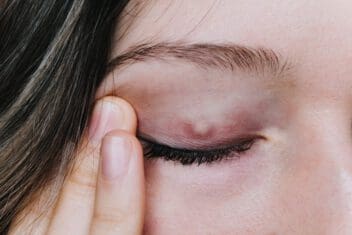Are Styes Contagious? Myths & Facts About Styes
Home / Eye Conditions & Eye Diseases / How to Get Rid of a Stye /
Last Updated:
Are eye styes contagious? It’s understandable that you might be concerned about spreading or catching a stye, especially because they affect such a sensitive area. The good news is that eye styes are not contagious. Keep reading to learn more.
Table of Contents
Styes are not contagious. Contrary to some myths about styes, they cannot be passed from one person to another.
Are Styes Contagious?
Styes are not contagious, as people cannot transmit them to one another.
However, if the bacteria is on a pillowcase or towel and comes into direct contact with an eye, the person is at risk for developing a stye. This is very rare.
You deserve clear vision. We can help.
With 135+ locations and over 2.5 million procedures performed, our board-certified eye surgeons deliver results you can trust. Your journey to better vision starts here.
What Causes Styes to Develop?
A stye develops when the eyelid’s oil glands become infected. Several factors can increase your risk of developing a stye:
- Not washing your hands and touching the eyes
- Failing to remove makeup before going to bed at night
- Having blepharitis, which is a condition that causes chronic inflammation along the eyelid’s edge
- Not thoroughly washing or disinfecting contact lenses before inserting them
- Using cosmetics that are expired or old
- Having rosacea, which is a type of skin condition that causes the skin on the face to become red
Who Typically Gets Styes?
People of all ages can get styes, including babies. Styes tend to be more common in children than in adults.
You are more likely to get a stye if you have had one before.
How to Know If a Stye Has Ruptured
A stye may appear similar to a pimple with a white head. If it ruptures, this head disappears and pus releases.
You may not notice when your stye ruptures. The swelling and redness may simply slowly dissipate.
Can You Pop a Stye?
Never pop a stye. It’s a myth that you can do this on your own.
Popping a stye puts you at risk for infection. It can also significantly increase pain, swelling, and other symptoms.
There are two types of styles: internal and external. The external type will usually rupture without intervention.
An internal stye occurs inside the eyelid. This type is considered more serious, and you could injure your eye if you try to pop it.
In many cases, this type does not rupture on its own. A doctor can drain it, but you should not attempt this at home. If you experience an internal stye, you should see your doctor because it can be more serious than an external one.
You deserve clear vision. We can help.
With 135+ locations and over 2.5 million procedures performed, our board-certified eye surgeons deliver results you can trust. Your journey to better vision starts here.
Will Styes Cause Problems With Vision?
While it is not common, a stye may affect your vision. If it gets large enough, it could cause a minor vision obstruction. Some people also report a degree of blurry vision in the affected eye.

When issues with vision occur, seek medical attention promptly. A doctor can drain the stye so it starts to heal faster. This will help to alleviate visual problems and other symptoms.
The usual symptoms of a stye include:
- A red lump that looks similar to a pimple or boil.
- Eyelid pain.
- Excessive tearing.
- Swelling of the affected eyelid.
Is Treatment Necessary for a Stye?
On average, a stye goes away within three to five days. To promote healing and alleviate some of the discomfort, there are several home methods you can try. Use these properly and treat the affected eye gently, so the stye does not become further irritated.
Try the following home treatment methods:
- Apply a warm compress to the stye to encourage it to drain. This will also help to dissolve any oil and pus in the area. Make sure the water is not too hot, and apply the compress for up to 10 minutes periodically.
- Use a mild soap to gently clean the eyelid two to three times a day.
- Use an over-the-counter pain medicine for discomfort.
- Do not wear contacts or makeup until it has healed fully.
- Apply an over-the-counter antibiotic ointment.
If the stye recurs after it has been successfully treated, it is best to consult with a doctor. People who develop styes often might need antibiotics.
While you can usually treat a stye using home care methods, visit a doctor if any of the following occur:
- Any swelling or redness that goes beyond the eyelid to other parts of the face
- Vision problems
- No improvement or worsening of the stye after 48 hours of home treatment
What Is the Difference Between a Stye and a Chalazia?

It is common for people to think a stye is a chalazia, and vice versa. Both of these issues cause a swollen lump, but a stye is at the eyelash base and a chalazia is on the eyelid itself. Initially, a chalazia may look like a stye if develops low on the eyelid.
Many of the symptoms are the same, such as redness and swelling. However, a chalazia typically does not cause pain while a stye is usually quite painful. Pain and the location of the lump are the primary differences between these two issues.
It is important to distinguish which one you have before attempting treatment. See a doctor to get an accurate diagnosis.
Can You Prevent a Stye?
While there may not be a way to fully prevent a stye, there are ways you can reduce your likelihood of developing one. Employ these methods:
- Always wash your hands, especially before touching your eyes. Use warm water and soap to wash your hands, and do this multiple times per day.
- Before inserting contact lenses, ensure they are fully clean and disinfected. Your optometrist or ophthalmologist can provide full instructions on how to properly care for your contact lenses.
- If you develop blepharitis, seek treatment immediately and follow your doctor’s treatment regimen exactly.
- Examine your cosmetics regularly to make sure they are still fresh. Liquid eyeliner, mascara, and eyeshadow should be replaced every three months. Always wash your face before bed and ensure that all your makeup is completely removed.
- If you have a history of developing styes, apply a warm compress to the area on a regular basis. This may reduce the risk of recurrence.
Anyone who has a stye should be careful to only use proven treatment methods or else it may become worse.
You deserve clear vision. We can help.
With 135+ locations and over 2.5 million procedures performed, our board-certified eye surgeons deliver results you can trust. Your journey to better vision starts here.
References
- Are Styes Contagious and What Can I Do About Them? (May 2018). American Academy of Ophthalmology.
- What Are Chalazia and Styes? (May 2019). American Academy of Ophthalmology.
- Sty. (June 2018). Mayo Clinic.
- Styes. (September 2015). KidsHealth from Nemours.
- Is It OK to Pop a Stye? (May 2014). American Academy of Ophthalmology.
- Styes and Chalazions. (April 2019). Harvard Medical School.
- Stye. Cedars Sinai.
- Styes in Children. University of Rochester Medical Center.
- Sty (Stye). Cleveland Clinic.
- Sty. Seattle Children’s.
This content is for informational purposes only. It may have been reviewed by a licensed physician, but is not intended to serve as a substitute for professional medical advice. Always consult your healthcare provider with any health concerns. For more, read our Privacy Policy and Editorial Policy.